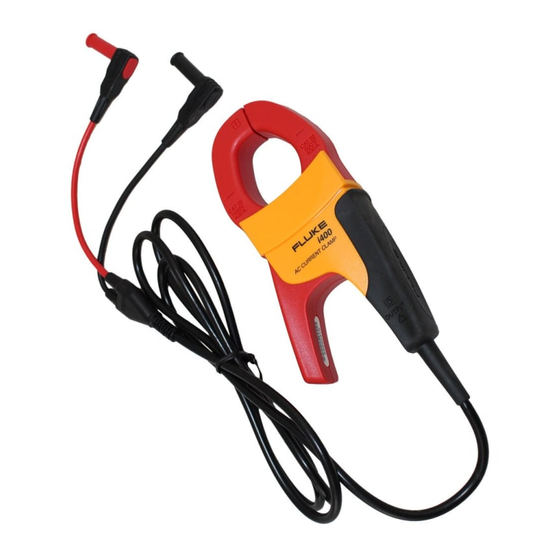Table of Contents
Advertisement
Quick Links
Introduction
To avoid electric shock or injury, do not perform the performance tests or
calibration procedures unless you are qualified to do so.
The information provided in this manual is for the use of qualified personnel
only.
The i400 Calibration Information provides the information necessary to verify the performance of the
Fluke i400 AC Current Clamp, hereafter known as the Current Clamp.
The following information is included in this document:
•
Safety Information and Electrical Symbols
•
Specifications
•
Maintenance
•
Performance Tests
•
User-Replaceable Parts
•
Warranty Statement
See the i400 Instruction Sheet for complete operating instructions.
Contact Information
To contact Fluke, call:
USA: 1-888-44-FLUKE (1-888-443-5853)
Canada: 1-800-36-FLUKE (1-800-363-5853)
Europe: +31 402-675-200
Japan: +81-3-3434-0181
Singapore: +65-738-5655
Anywhere in the world: +1-425-446-5500
USA Service: 1-888-99-FLUKE (1-888-993-5853)
For additional information about Fluke, its products, and services, visit Fluke's web site at:
www.fluke.com
To register this product, go to
2414311
PN
March 2005 Rev.1, 10/05
© 2005 Fluke Corporation. All rights reserved. Printed in U.S.A.
XWWarning
register.fluke.com
AC Current Clamp
Calibration Information
®
i400
1
Advertisement
Table of Contents

Summary of Contents for Fluke i400
- Page 1 The information provided in this manual is for the use of qualified personnel only. The i400 Calibration Information provides the information necessary to verify the performance of the Fluke i400 AC Current Clamp, hereafter known as the Current Clamp. The following information is included in this document: •...
-
Page 2: Safety Information
Calibration Information Safety Information XW Read First: Safety Information To ensure safe operation and service of the Current Clamp, follow these instructions: • Read the operating instructions before use and follow all safety instructions. • Use the Current Clamp only as specified in the operating instructions, otherwise the clamp’s safety features may not protect you. -
Page 3: Safety Specifications
AC Current Clamp Safety Specifications Tactile Barrier bbs03f.eps Figure 1. Tactile Barrier Safety Specifications Category Rating: CAT III 1000 V and CAT IV 600 V per EN/IEC61010-1, Pollution Degree 2 Tested to US and Canadian standards for compliance to UL 61010-1 and CAN/CSA C22.2 No. -
Page 4: General Specifications
Do not use a damaged Current Clamp. If a clamp is damaged, tape it shut to prevent unintended operation. A damaged clamp under warranty will be promptly repaired or replaced (at Fluke’s discretion) and returned at no extra charge. If the Current Clamp does not work or perform properly, use the following steps to help isolate the problem: 1. -
Page 5: Performance Tests
Clamp’s specifications. If the Current Clamp fails any part of the test, adjustment or repair is indicated. Refer to “Contacting Fluke” for service phone numbers. In the performance tests, the Current Clamp is referred to as the unit under test (UUT). - Page 6 408.06 mA *To obtain the best TUR, the Fluke 189 is pre-calibrated at each step using the 5520A with LCOMP OFF. The Fluke 189 error is then algebraically added to the UUT reading. The Fluke 189 must be in a mA B function.
- Page 7 Figure 3. Connections for Current-Accuracy Test (Steps 2 and 3) User-Replaceable Parts The Current Clamp contains no user-replaceable parts. Table 4 lists user documentation that is available for this product. Table 4. User Documentation Description Part No i400 Instruction Sheet 2282667 i400 Calibration Information 2414311 (this document)
- Page 8 Parts, product repairs, and services are warranted for 90 days. This warranty extends only to the original buyer or end-user customer of a Fluke authorized reseller, and does not apply to fuses, disposable batteries, or to any product which, in Fluke's opinion, has been misused, altered, neglected, contaminated, or damaged by accident or abnormal conditions of operation or handling.














Need help?
Do you have a question about the i400 and is the answer not in the manual?
Questions and answers